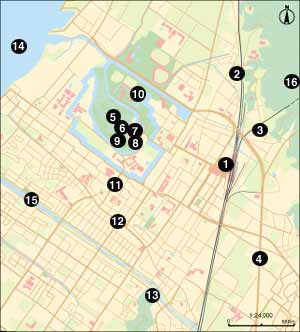|
In one district, once called uoya-machi (fish dealers' quarter), the houses have wells beside their front doors. You might wonder, was the water used to wash fish? Walk down a narrow street where foot soldiers lived, and you might start to imagine some of them jumping out at you. Letting your imagination run free like this is one of the pleasures of strolling about a castle town.
Hikone was laid out in typical castle-town fashion, but its defenses were never needed. By the time the castle was completed, in 1622, Japan had been unified under the military government in Edo (present-day Tokyo), and the country had entered a long period of peace.
Peace meant financial difficulty for the artisans who manufactured armor and weapons. Without war, they found themselves unemployed. So they developed new skills, making Buddhist altars for the home. Each altar is shaped like a cabinet, and houses a statue of the Buddha and objects commemorating the memory of deceased relatives. Hikone's altars are skillfully made and have earned themselves an excellent name throughout Japan.
The artisans making them today have inherited techniques that go back hundreds of years. One craftsman, Tsuji Ryuzo, has been working in this field for 50 years. He's more than 70 now, but he's still busy shaping pieces of wood with a plane and fitting them together. His father and grandfather both worked in this same field, and he is carrying on Hikone's traditional craftsmanship.
Tsuji is very proud of his native city: "The past lives on in Hikone, and you can feel history in the air. I suppose that's because we haven't kept up with modern trends. But that's OK--it's very important to preserve the good things from the past."
Tradition and history are very much alive in Hikone. The city still gives us the feeling of the Edo period (1603-1867), and this is important today, when so much of the past is being lost. The tile roofs and latticework doors are two elements from another era that many Japanese get nostalgic about. Tourists from all over Japan come here on their holidays to enjoy a stroll through the castle town. 
 |
